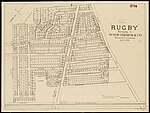Blue Hill Avenue station
1855 establishments in Massachusetts1944 disestablishments in Massachusetts2019 establishments in MassachusettsFormer New York, New Haven and Hartford Railroad stationsMBTA Commuter Rail stations in Boston ... and 5 more
Mattapan, BostonRailway stations in the United States closed in 1944Railway stations in the United States opened in 1855Railway stations in the United States opened in 2019Use mdy dates from December 2018

Blue Hill Avenue station is a regional rail station on the MBTA Commuter Rail Fairmount Line located in the Mattapan neighborhood of Dochester, Boston, Massachusetts. The station consists of a center island platform between the line's two tracks, with handicapped-accessible ramps to Blue Hill Avenue and Cummins Highway. Originally intended to open along with Newmarket, Four Corners/Geneva, and Talbot Avenue, it was significantly delayed due to local controversy. Construction began in 2017, and the station opened on February 25, 2019.
Excerpt from the Wikipedia article Blue Hill Avenue station (License: CC BY-SA 3.0, Authors, Images).Blue Hill Avenue station
Messinger Street, Boston Mattapan
Geographical coordinates (GPS) Address Website External links Nearby Places Show on map
Geographical coordinates (GPS)
| Latitude | Longitude |
|---|---|
| N 42.2714 ° | E -71.0959 ° |
Address
Blue Hill Avenue
Messinger Street
02126 Boston, Mattapan
Massachusetts, United States
Open on Google Maps








